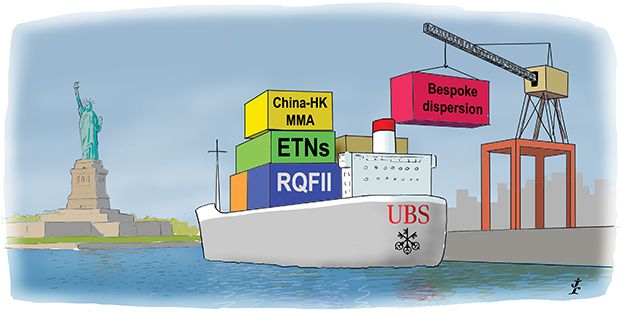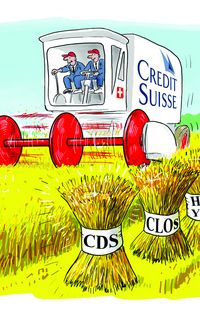After bowing to regulatory pressure to cut back in fixed income, UBS opted to revive its scarred equity derivatives franchise, creating a stable, content-driven, returns-focused operation around its expansive wealth management arm. For defying the odds to achieve its global ambitions while increasing its share in core markets, UBS is IFR’s Equity Derivatives House of the Year.
One of the banks hit hardest by the financial crisis, and battered further by a rogue trading scandal in its delta-one business in 2011, UBS faced no small amount of scepticism when it launched its ambitious equity derivatives rebuild. But in 2014, the firm cemented its position as a market mainstay.
In shaping the business around the US$2trn of assets in its wealth division, UBS has created a unique operation designed to be steady and sustainable – one that can weather the cyclical ups and downs.
As a result, the firm enjoyed its best third-quarter equity revenues since 2010, which senior management said was driven largely by derivatives.
“Our main goal was to demonstrate that an outstanding 2013 was sustainable and not a one-off. We set out 2014 with clearly stated goals to build sustainable revenues. We have the best returns of any derivatives business,” said Roger Naylor, global head of equity derivatives.
“We’re number one in public distribution, we have a developing corporate business, we’re trading more non-linear product and are operating in more geographies, including emerging markets.”
With leading positions in Europe and Asia, the firm saw the United States as the missing piece of the puzzle. A new US management team boosted market share of exchange-traded notes from 12% to 18%, with US$1.5bn of notional added, providing a foothold in a region dominated by local houses.
“The type of business that US banks do is very capital and balance-sheet intensive and often depends on lending relationships,” said Naylor. “We don’t want to deploy our balance sheet at 50bp, so we’ll never be top three there in revenue. But we’re interested in high-return opportunities in the synthetic space.”
Content-driven investment ideas were key to the firm’s success. With its leading Asian franchise, UBS offered access to strict quotas slapped on foreign investment in the region.
“Asia has been an underperformer for many banks this year, but we’ve got such a deep franchise in the region, we’ve been able to find idiosyncratic opportunities,” said Shane Edwards, global head of structuring.
Through partnerships with Hong Kong asset managers that afforded Renminbi Qualified Foreign Institutional Investor status, UBS clients could access funds linked to China onshore bonds.
“These funds aren’t simple to set up as they depend on gaining access to someone else’s RQFII quota,” said Patrick Grob, head of sales in EMEA. “As the world’s largest private bank, it’s not so difficult for us to achieve those partnerships.”
Over US$1.25bn was traded through the year, with significant demand for leveraged notes issued through an SPV and linked to RFQII bond funds.
“Yield enhancement is a recurring theme, and this offers a double layer of enhancement,” said Edwards. “With three times leverage, you can make 8%–10%.”
The bank pioneered notes linked to baskets of China A shares that were expected to outperform on plans for mutual market access between China and Hong Kong.
“It’s a trade that requires a very strong cash franchise, as you need to buy A shares and sell H shares. We’re the only ones who’ve done that type of trade,” said Edwards.
Technology proved pivotal. The bank offered actively managed certificates through its NEO platform, enabling clients to refine strategies, quantify risk and performance, and submit orders across multiple asset classes.
“We see a lot of asset managers use AMCs before they launch a fund,” said Grob. “It is a very short time to market and lower cost, so we think this is the perfect intermediate solution to get live and get a track record.”
A white-labelled version of UBS’s structured product platform was rolled out to clients in July, generating around 60,000 trades across almost 4,000 products.
With an expanding structured products business, flow became increasingly important in order to recycle risk.
“We want to recycle interesting risk to clients. We want to offer clients risk that we would like to keep, but can’t because of our limits,” said Naylor.
The bank found strong demand for bespoke dispersion trades that addressed the eroding returns on traditional structures as single stock vol took a tumble.
“When vol is squashed down, you need to find a product that is long convexity but with positive carry,” said Pete Clarke, head of equity derivatives strategy. “It makes sense to focus on names that are more reactive and identify a single stock position with the right beta profile.”
While others fled from emerging markets, UBS found new opportunities. Russia might have been the worst performing stock market of the year, but India was the best – and the bank traded more than US$20bn notional on Indian equity underlyings.
To see the digital version of the IFR Review of the Year, please click here.
To purchase printed copies or a PDF of this report, please email gloria.balbastro@thomsonreuters.com.




